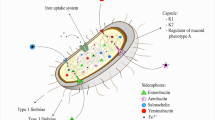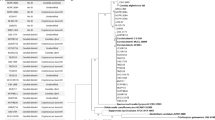Abstract
Different methods have been used to perform the molecular characterization of Cryptococcus neoformans. Among them, RAPD analysis is able to separate isolates of the same species and genotypes. This study aimed to evaluate clinical and environmental C. neoformans isolates from Minas Gerais, Brazil by RAPD and correlate the genetic profiles with the ones obtained by URA5-RFLP, virulence factors and antifungal susceptibility patterns. Forty-five environmental (31 from areas surrounding hospital and 14 from captive bird droppings from pet-shops) and 29 clinical C. neoformans isolates were evaluated. Antifungal susceptibility tests (Clinical and Laboratory Standards Institute), URA5-RFLP analysis and the assessment of virulence factors were performed according to their original descriptions. RAPD profiles were obtained using the L15996 primer (5′-CTCCACCATTAGCACCCAAAGC-3′). RAPD analysis generated two to 20 bands for all studied isolates. The isolates presented similarities ranging from 10.8 to 100.0%. Considering a minimum identity score of 50%, four clusters were formed. Cluster I contained 10 pet-shops bird dropping isolates, cluster II contained 22 clinical isolates most of them recovered from cerebrospinal fluid, cluster III contained 14 isolates from hospital surroundings and cluster IV contained 12 environmental isolates most from hospital surroundings. Fourteen isolates were not grouped. The RAPD profiles were clustered according to their source and URA5-RFLP pattern. No correlation between virulence factors or antifungal susceptibility profile with the obtained RAPD profiles was observed.


Similar content being viewed by others
References
Emmons CW. Saprophytic sources of Cryptococcus neoformans associated with the pigeon (Columba livia). Am J Hyg. 1955;62(3):227–32.
Lazera MS, Cavalcanti MA, Trilles L, Nishikawa MM, Wanke B. Cryptococcus neoformans var. gattii-evidence for a natural habitat related to decaying wood in a pottery tree hollow. Med Mycol. 1998;36(2):119–22.
Mitchell TG, Perfect JR. Cryptococcosis in the era of AIDS–100 years after the discovery of Cryptococcus neoformans. Clin Microbiol Rev. 1995;8(4):515–48.
Simwami SP, Khayhan K, Henk DA, Aanensen DM, Boekhout T, Hagen F, Brouwer AE, Harrison TS, Donnelly CA, Fisher MC. Low diversity Cryptococcus neoformans variety grubii multilocus sequence types from Thailand are consistent with an ancestral African origin. PLoS Pathog. 2011;7(4):e1001343.
Meyer W, Castaneda A, Jackson S, Huynh M, Castaneda E. Molecular typing of IberoAmerican Cryptococcus neoformans isolates. Emerg Infect Dis. 2003;9(2):189–95.
Meyer W, Marszewska K, Amirmostofian M, Igreja RP, Hardtke C, Methling K, Viviani MA, Chindamporn A, Sukroongreung S, John MA, Ellis DH, Sorrell TC. Molecular typing of global isolates of Cryptococcus neoformans var. neoformans by polymerase chain reaction fingerprinting and randomly amplified polymorphic DNA—a pilot study to standardize techniques on which to base a detailed epidemiological survey. Electrophoresis. 1999;20(8):1790–9.
Boekhout T, Theelen B, Diaz M, Fell JW, Hop WC, Abeln EC, Dromer F, Meyer W. Hybrid genotypes in the pathogenic yeast Cryptococcus neoformans. Microbiology. 2001;147(Pt 4):891–907.
Almeida AM, Matsumoto MT, Baeza LC, de Oliveira ESRB, Kleiner AA, Melhem MS, Mendes Giannini MJ. Molecular typing and antifungal susceptibility of clinical sequential isolates of Cryptococcus neoformans from Sao Paulo State, Brazil. FEMS Yeast Res. 2007;7(1):152–64.
Meyer W, Aanensen DM, Boekhout T, Cogliati M, Diaz MR, Esposto MC, Fisher M, Gilgado F, Hagen F, Kaocharoen S, Litvintseva AP, Mitchell TG, Simwami SP, Trilles L, Viviani MA, Kwon-Chung J. Consensus multi-locus sequence typing scheme for Cryptococcus neoformans and Cryptococcus gattii. Med Mycol. 2009;47(6):561–70.
Casali AK, Goulart L, Rosa e Silva LK, Ribeiro AM, Amaral AA, Alves SH, Schrank A, Meyer W, Vainstein MH. Molecular typing of clinical and environmental Cryptococcus neoformans isolates in the Brazilian state Rio Grande do Sul. FEMS Yeast Res. 2003;3(4):405–15.
Lugarini C, Goebel CS, Condas LA, Muro MD, de Farias MR, Ferreira FM, Vainstein MH. Cryptococcus neoformans Isolated from Passerine and Psittacine bird excreta in the state of Parana Brazil. Mycopathologia. 2008;166(2):61–9.
Pernice I, Lo Passo C, Criseo G, Pernice A, Todaro-Luck F. Molecular subtyping of clinical and environmental strains of Cryptococcus neoformans variety neoformans serotype A isolated from southern Italy. Mycoses. 1998;41(3-4):117–24.
Sansinforiano ME, Rabasco A, Martinez-Trancon M, Parejo JC, Hermoso-de-Mendoza M, Padilla JA. Optimization of the conditions for RAPD-PCR of Candida spp. and Cryptococcus spp. Rev Iberoam Micol. 2001;18(2):65–9.
Martins MA, Pappalardo MC, Melhem MS, Pereira-Chioccola VL. Molecular diversity of serial Cryptococcus neoformans isolates from AIDS patients in the city of Sao Paulo Brazil. Mem Inst Oswaldo Cruz. 2007;102(7):777–84.
Vigilant L, Pennington R, Harpending H, Kocher TD, Wilson AC. Mitochondrial DNA sequences in single hairs from a southern African population. Proc Natl Acad Sci USA. 1989;86(23):9350–4.
Steindel M, Dias Neto E, de Menezes CL, Romanha AJ, Simpson AJ. Random amplified polymorphic DNA analysis of Trypanosoma cruzi strains. Mol Biochem Parasitol. 1993;60(1):71–9.
Steindel M, Dias Neto E, Pinto CJ, Grisard EC, Menezes CL, Murta SM, Simpson AJ, Romanha AJ. Randomly amplified polymorphic DNA (RAPD) and isoenzyme analysis of Trypanosoma rangeli strains. J Eukaryot Microbiol. 1994;41(3):261–7.
Gomes RF, Macedo AM, Pena SD, Melo MN. Leishmania (Viannia) braziliensis: genetic relationships between strains isolated from different areas of Brazil as revealed by DNA fingerprinting and RAPD. Exp Parasitol. 1995;80(4):681–7.
Aleixo DL, Ferraz FN, de Melo CS, Gomes ML, Toledo MJ, Kaneshima EN, Bersani-Amado CA, Araujo SM. Changes of RAPD profile of Trypanosoma cruzi II with Canova and Benznidazole. Homeopathy. 2008;97(2):59–64.
Martinez-Diaz RA, Escario JA, Nogal-Ruiz JJ, Gomez-Barrio A. Relationship between biological behaviour and randomly amplified polymorphic DNA profiles of Trypanosoma cruzi strains. Mem Inst Oswaldo Cruz. 2001;96(2):251–6.
D’Avila DA, Gontijo ED, Lages-Silva E, Meira WS, Chiari E, Galvao LM. Random amplified polymorphic DNA profiles of Trypanosoma cruzi isolates from chagasic patients with different clinical forms. Parasitol Res. 2006;98(5):455–61.
CLSI, editor. Reference method for broth dilution antifungal susceptibility testing of yeasts; approved standard, 3rd edn. CLSI document M27-A3. Wayne: Clinical and Laboratory Standards Institute; 2008.
Costa AK, Sidrim JJ, Cordeiro RA, Brilhante RS, Monteiro AJ, Rocha MF. Urban pigeons (Columba livia) as a potential source of pathogenic yeasts: a focus on antifungal susceptibility of Cryptococcus strains in Northeast Brazil. Mycopathologia. 2010;169(3):207–13.
Zaragoza O, Casadevall A. Experimental modulation of capsule size in Cryptococcus neoformans. Biol Proced Online. 2004;6:10–5.
Samaranayake LP, Raeside JM, MacFarlane TW. Factors affecting the phospholipase activity of Candida species in vitro. Sabouraudia. 1984;22(3):201–7.
Price MF, Wilkinson ID, Gentry LO. Plate method for detection of phospholipase activity in Candida albicans. Sabouraudia. 1982;20(1):7–14.
Matsumoto MT, Fusco-Almeida AM, Baeza LC, Melhem MS, Medes-Giannini MJ. Genotyping, serotyping and determination of mating-type of Cryptococcus neoformans clinical isolates from Sao Paulo State, Brazil. Rev Inst Med Trop Sao Paulo. 2007;49(1):41–7.
Yamamoto Y, Kohno S, Koga H, Kakeya H, Tomono K, Kaku M, Yamazaki T, Arisawa M, Hara K. Random amplified polymorphic DNA analysis of clinically and environmentally isolated Cryptococcus neoformans in Nagasaki. J Clin Microbiol. 1995;33(12):3328–32.
Horta JA, Staats CC, Casali AK, Ribeiro AM, Schrank IS, Schrank A, Vainstein MH. Epidemiological aspects of clinical and environmental Cryptococcus neoformans isolates in the Brazilian state Rio Grande do Sul. Med Mycol. 2002;40(6):565–71.
Andrade-Silva L, Ferreira-Paim K, Silva-Vergara ML, Pedrosa AL. Molecular characterization and evaluation of virulence factors of Cryptococcus laurentii and Cryptococcus neoformans strains isolated from external hospital areas. Fungal Biol. 2010;114(5–6):438–45.
Hunter PR, Fraser CA. Application of the theory of adaptive polymorphism to the ecology and epidemiology of pathogenic yeasts. Appl Environ Microbiol. 1990;56(7):2219–22.
Acknowledgments
We thank Miss Angela Azor for her technical assistance, Dr. Claudia Leite Maffei and Dr. Lúcia Kioko Hasimoto e Souza for kindly providing the reference strains of the eight major molecular types of the C. neoformans/C. gattii species complex. Also, we are grateful with Professor Wieland Meyer for the valuable comments and suggestions to improve the manuscript. This work was supported by a Grant Edital Universal APQ-01735/2010 form the Fundação de Amparo à Pesquisa de Minas Gerais FAPEMIG to Mario León Silva-Vergara.
Author information
Authors and Affiliations
Corresponding author
Rights and permissions
About this article
Cite this article
Andrade-Silva, L., Ferreira-Paim, K., Mora, D.J. et al. RAPD Analysis with the Primer L15996 of Brazilian Clinical and Environmental Cryptococcus neoformans Isolates. Mycopathologia 174, 53–59 (2012). https://doi.org/10.1007/s11046-011-9515-6
Received:
Accepted:
Published:
Issue Date:
DOI: https://doi.org/10.1007/s11046-011-9515-6




